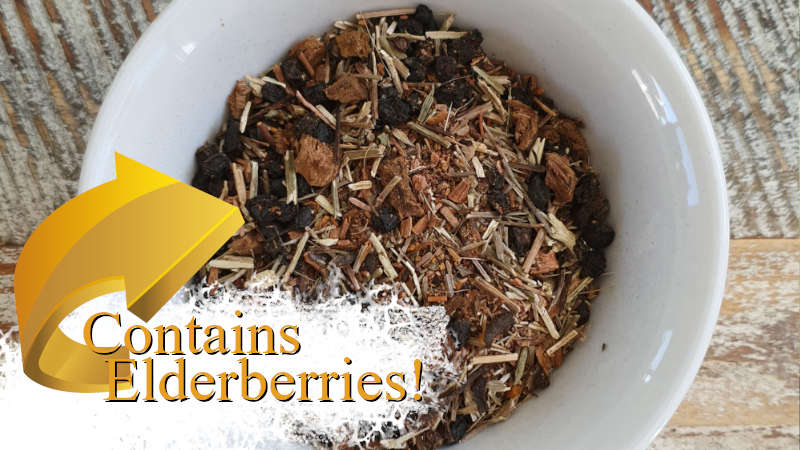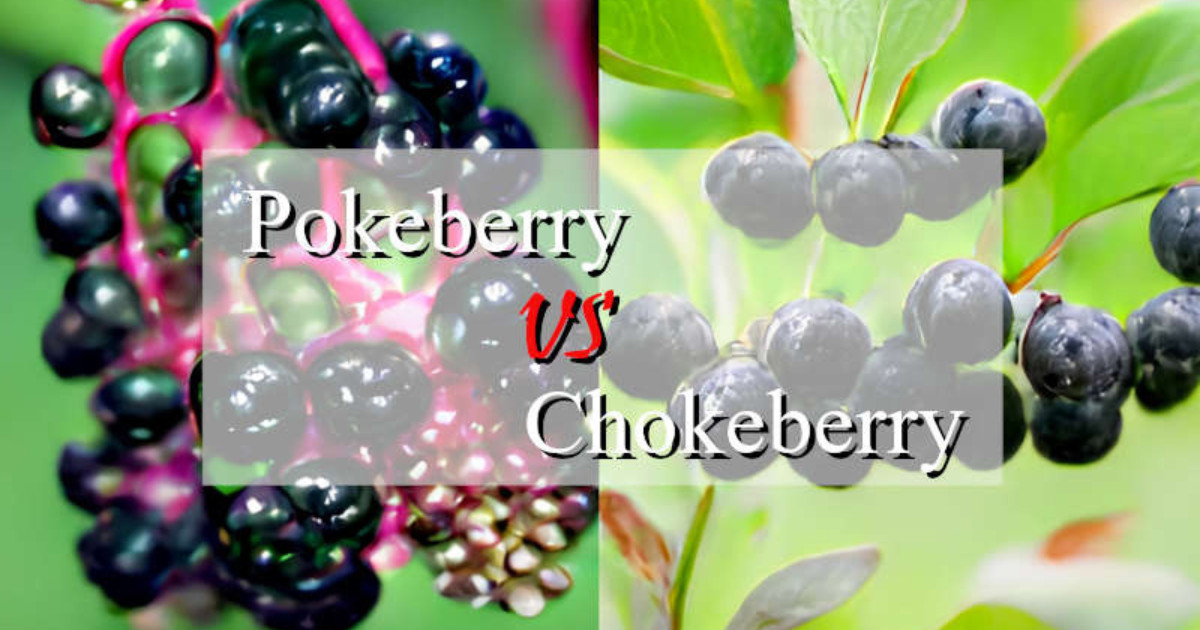As we dig a little deeper into our series connected to elderberries and what can sometimes be confused with them, we find ourselves exploring the pokeberry vs chokeberry topic.
Neither pokeberries nor chokeberries are the same thing as elderberry. But there are aspects of these two that are worth learning about.
Where the relevance of elderberry comes in here is that HerbiTea’s Iron Fluorine tea contains elderberries, and in the interest of education, I feel that it is appropriate to open the discussion about chokeberry vs pokeberry and include this.
Elderberry can be mistaken for the wrong kind of fruit. Some of these can be toxic. So, for those who plan to use the ingredients list to forage for their berries, be aware that there are some poisonous lookalikes out there.

Table of Contents
The Low Down on Pokeberry vs Chokeberry
If you want to find out more about pokeberries we have a comparison article you can dive into. This will help with figuring out what they look like, where they grow, and some other considerations about them.
The biggest consideration to make here is that pokeberries are considered to be toxic and should not be consumed. 1 2
Are Chokeberries Safe for Humans?
The burning question right here tends to be ‘Are chokeberries poisonous to humans?’
Chokeberry, in contrast to pokeberry, is edible and is often used in jams, jellies, and pies. The fruit has a tart flavour and is high in antioxidants and nutrients. The fruit can be eaten fresh or used in cooking. It is also sometimes used to make wine.
The leaves, stems, and seeds of the plant are not considered to be edible. 3
It is important to note that some people may have allergic reactions to the fruit of the black chokeberry. 4
Identifying Black Chokeberry Aronia Melanocarpa
Black chokeberry (Aronia melanocarpa) is a shrub that is native to eastern North America. It is commonly found in wooded areas, swamps, and along streams.
It can grow to be up to 10 feet tall and has small white flowers that bloom in the spring. The fruit of the black chokeberry is a small, black berry that is ripe in the fall. The leaves of the plant are oval-shaped and have serrated edges.
They are green in the summer and turn red or purple in the fall. Black chokeberry is known for its ability to tolerate wet, poorly drained soils and its ability to grow in partial shade. It is also tolerant of drought and cold temperatures.
The fruit is generally considered to be safe to eat when it is ripe and has been properly prepared.
To prepare the fruit for use in cooking, or for eating fresh, you can wash it thoroughly under running water to remove any dirt or debris. It is also a good idea to remove the stems and any bruised or damaged fruit.
The fruit can be eaten raw or cooked. If consumed raw, it may prove to be unpalatable as the fruit can be quite astringent.
What does it Mean if the Fruit is Astringent?
If the fruit is (too) astringent, it means that it has a very dry, puckery taste that can make your mouth feel tight or parched.
This is usually caused by high levels of tannins in the fruit. Tannins are plant compounds that have a bitter or astringent taste and can cause your mouth to feel dry or puckered.
In the case of the black chokeberry, the astringency is usually less noticeable in fully ripe fruit. However, if the fruit is not fully ripe or if it has been damaged in some way, it may be more astringent.
If you find that the fruit of the black chokeberry is too astringent to eat fresh, you can try cooking it to reduce the astringency. Cooking the fruit can help to break down the tannins and make the fruit more palatable.
You can also try adding sweeteners or combining the fruit with sweeter fruits to balance out the astringency. Alternatively, you can try drying the fruit, which can help to reduce the astringency and intensify the fruit’s natural sweetness.
The fruit of the black chokeberry is high in antioxidants and nutrients. It can be dried or frozen for later use.
Are Chokecherries the same as Chokeberries?
Chokecherries (Prunus virginiana) are different to chokeberries. Both are generally considered safe to eat but will require some perpetration.
In another article, we take a closer look at the question ‘What are chokecherries good for?’ where we consider the benefits of chokecherry, and take a deeper look at the use of chokecherry vs chokeberry leaves and fruit.
Being able to spot the right plant is important as there are some chokeberry and chokecherry poisonous look-alikes that you don’t want to be on the wrong side of. These commonly include:
- Buckthorn (Rhamnus cathartica) 5
- Parts of the Black Cherry (Prunus serotina) 6
- Bitter Cherry (Prunus emarginata) 7
Black Chokeberry Benefits
Black chokeberry may support several health functions. Some potential benefits of black chokeberry include the it:
- May improve heart health
- Some studies have suggested that black chokeberry may help to reduce high blood pressure and cholesterol levels, which are risk factors for heart disease. 8
- May have anti-inflammatory effects
- The antioxidants in black chokeberry may help to reduce inflammation in the body, which may be beneficial for conditions such as arthritis and asthma. 9
- May boost the immune system
- The high levels of antioxidants in black chokeberry may help to strengthen the immune system, helping the body fight off infections and diseases. 10
- May have anti-cancer properties
- Some research has suggested that the antioxidants in black chokeberry may have anti-cancer properties and may help inhibit the growth of certain types of cancer cells. 11
- May improve brain function
- Some studies have suggested that black chokeberry may have neuroprotective effects and may help to improve brain function and cognitive performance. 12
5 Pokeberry vs Chokeberry FAQs
Is Pokeweed and Pokeberry the Same Thing?
Although pokeweed and pokeberry aren’t strictly the same thing, they are from the same plant. The berry (pokeberry) is the fruiting body, while the weed (pokeweed) is the non-fruiting body.
Is a Chokecherry and a Chokeberry the Same Thing?
No, chokecherry (Prunus virginiana) and chokeberry (Aronia melanocarpa) are two different types of plants.
Chokecherry is a type of flowering tree or shrub that is native to North America. It produces small, dark purple or black berries that are bitter and astringent in taste. Chokecherries are often used in a range of different food products such as jams and baked goods.
Chokeberry, on the other hand, is a type of shrub that is native to North America. It produces small, black berries that are high in antioxidants. Chokeberries are often used in supplements and juice forms.
Although the names are similar, chokecherries and chokeberries are not the same plant and have different characteristics and uses.
Are Poke Berries Poisonous to Touch?
In general, pokeberries are not considered to be poisonous if they come into contact with the skin, but they may cause some irritation or allergic reactions in some people.
Will Poke Berries Kill You?
The berries and other parts of the plant contain toxins that can be harmful if ingested in large amounts. In general, pokeberries are not considered to be deadly, but they can cause serious symptoms if ingested, including vomiting, diarrhea, and stomach pain.
It is important to note that the toxicity of pokeberries can vary based on the age of the plant, the part of the plant that is ingested, and the individual’s age and overall health. Children and pets are more likely to be affected by pokeberries than adults because of their smaller size and weight.
Is Elderberry and Pokeberry the Same Thing?
No. These are completely different plants and fruits. Elderberry may be consumed after processing, whereas pokeberry (fruit) is toxic and should not be consumed at all.
Conclusion
It is important to note that more research is needed to fully understand the potential health benefits of these chokeberries. As edible berries in the pokeberry vs chokeberry discussion, more research is required to determine the appropriate dosage and long-term safety.
As with any supplements or diet changes, it is always a good idea to speak with a qualified professional before adding something like black chokeberry to your diet.
References
- “Phytolacca americana” – Wikipedia, Last checked 2 January 2023 [Wikipedia] [Archive] ↩︎
- “Pokeweed (Phytolacca americana)” – Children’s Health Queensland Hospital and Health Service Staff, 20 July 2017 [Queensland Health] [Archive] ↩︎
- “Cyanide-poisoned Moose Ornamental Chokecherry Tree a Devil in Disguise” – R. Woodford, C. Harms, March 2011 [Alaska Department of Fish and Game] [Archive] ↩︎
- “Anaphylactic shock following ingestion of aronia juice in a patient with type 2 diabetes.” – M. Mikołajczyk-Solińska, M. Kosmalski, J. Drzewoski, January 2014 [ResearchGate] [Archive] ↩︎
- “Common Buckthorn” – Notional Invasive Species Information Center Staff, Last Checked 5 January 2023 [USDA] [Archive] ↩︎
- “Prunus serotina” – North Carolina State University, Last Checked 5 January 2023 [North Carolina State University] [Archive] ↩︎
- “Bitter Cherry Prunus emarginata” – CalScape Staff, Last Checked 5 January 2023 [CalScape] [Archive] ↩︎
- “The Efficacy of Black Chokeberry Fruits against Cardiovascular Diseases” – K. Kasprzak-Drozd, T. Oniszczuk, J. Soja, M. Gancarz, K. Wojtunik-Kulesza, E. Markut-Miotła, A. Oniszczuk, 18 June 2021 [PubMed] [Archive] ↩︎
- “Functional Foods for Health: The Interrelated Antioxidant and Anti-Inflammatory Role of Fruits, Vegetables, Herbs, Spices and Cocoa in Humans” – M. Serafini, I. Peluso, December 2016 [PubMed] [Archive] ↩︎
- “Potential Benefits of Black Chokeberry (Aronia melanocarpa) Fruits and Their Constituents in Improving Human Health” – Y. Ren, T. Frank, G. Meyer, J. Lei , J. R. Grebenc, R. Slaughter, Y. G. Gao, A. D. Kinghorn, 13 November 2022 [MDPI] [Archive] ↩︎
- “Fruits of Black Chokeberry Aronia melanocarpa in the Prevention of Chronic Diseases” – T. Jurikova, J. Mlcek, S. Skrovankova, D. Sumczynski, J. Sochor, I. Hlavacova, L. Snopek, J. Orsavova, 7 June 2017 [PubMed] [Archive] ↩︎
- “Isolation of Neuroprotective Anthocyanins from Black Chokeberry (Aronia melanocarpa) against Amyloid-β-Induced Cognitive Impairment” – H. Wen, H. Cui, H. Tian, X. Zhang, L. Ma, C. Ramassamy, J. Li, 29 December 2020 [PubMed] [Archive] ↩︎
Last Updated on 2 months by D&C Editorial Team


